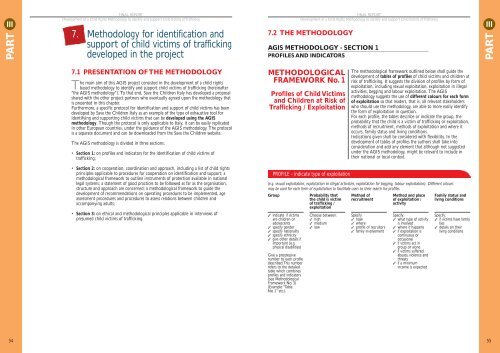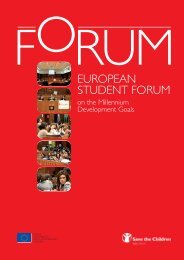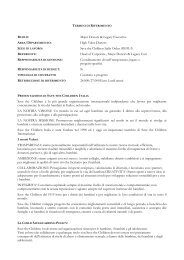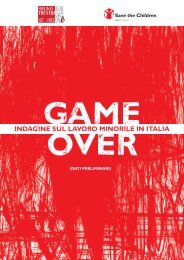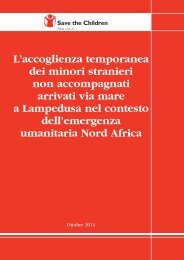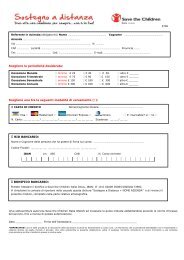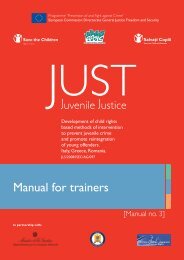FINAL REPORT - Save the Children Italia Onlus
FINAL REPORT - Save the Children Italia Onlus
FINAL REPORT - Save the Children Italia Onlus
You also want an ePaper? Increase the reach of your titles
YUMPU automatically turns print PDFs into web optimized ePapers that Google loves.
IIIPART<strong>FINAL</strong> <strong>REPORT</strong>Development of a Child Rights Methodology to Identify and Support Child Victims of Trafficking7. Methodology for identification andsupport of child victims of traffickingdeveloped in <strong>the</strong> project<strong>FINAL</strong> <strong>REPORT</strong>Development of a Child Rights Methodology to Identify and Support Child Victims of Trafficking7.2 THE METHODOLOGYAGIS METHODOLOGY - SECTION 1PROFILES AND INDICATORSIIIPART7.1 PRESENTATION OF THE METHODOLOGYThe main aim of this AGIS project consisted in <strong>the</strong> development of a child rightsbased methodology to identify and support child victims of trafficking (hereinafter“<strong>the</strong> AGIS methodology”). To that end, <strong>Save</strong> <strong>the</strong> <strong>Children</strong> Italy has developed a proposalshared with <strong>the</strong> o<strong>the</strong>r project partners who eventually agreed upon <strong>the</strong> methodology thatis presented in this chapter.Fur<strong>the</strong>rmore, a specific protocol for identification and support of child victims has beendeveloped by <strong>Save</strong> <strong>the</strong> <strong>Children</strong> Italy as an example of <strong>the</strong> type of exhaustive tool foridentifying and supporting child victims that can be developed using <strong>the</strong> AGISmethodology. Though <strong>the</strong> protocol is only applicable to Italy, it can be easily replicatedin o<strong>the</strong>r European countries, under <strong>the</strong> guidance of <strong>the</strong> AGIS methodology. The protocolis a separate document and can be downloaded from <strong>the</strong> <strong>Save</strong> <strong>the</strong> <strong>Children</strong> website.The AGIS methodology is divided in three sections:• Section 1: on profiles and indicators for <strong>the</strong> identification of child victims oftrafficking;METHODOLOGICALFRAMEWORK No. 1Profiles of Child Victimsand <strong>Children</strong> at Risk ofTrafficking / ExploitationThe methodological framework outlined below shall guide <strong>the</strong>development of tables of profiles of child victims and children atrisk of trafficking. It suggests <strong>the</strong> division of profiles by form ofexploitation, including sexual exploitation, exploitation in illegalactivities, begging and labour exploitation. The AGISmethodology suggests <strong>the</strong> use of different colours for each formof exploitation so that readers, that is, all relevant stakeholderswho should use <strong>the</strong> methodology, are able to more easily identify<strong>the</strong> form of exploitation in question.For each profile, <strong>the</strong> tables describe or indicate <strong>the</strong> group, <strong>the</strong>probability that <strong>the</strong> child is a victim of trafficking or exploitation,methods of recruitment, methods of exploitation and where itoccurs, family status and living conditions.Indications given shall be considered with flexibility. In <strong>the</strong>development of tables of profiles <strong>the</strong> authors shall take intoconsideration and add any element that although not suggestedunder <strong>the</strong> AGIS methodology, might be relevant to include in<strong>the</strong>ir national or local context.• Section 2: on cooperation, coordination and approach, including a list of child rightsprinciples applicable to procedures for cooperation on identification and support; amethodological framework to outline instruments of protection available in nationallegal systems; a statement of good practices to be followed as far as <strong>the</strong> organisation,structure and approach are concerned; a methodological framework to guide <strong>the</strong>development of recommendations on operating procedures to be implemented, ageassessment procedures and procedures to assess relations between children andaccompanying adults;• Section 3: on ethical and methodological principles applicable in interviews ofpresumed child victims of trafficking.PROFILE - indicate type of exploitation(e.g. sexual exploitation, exploitation in illegal activities, exploitation for begging, labour exploitation). Different coloursmay be used for each form of exploitation to facilitate users in <strong>the</strong>ir search for profiles.Group✓ Indicate if victimsare children oradolescents✓ specify gender✓ specify nationality✓ specify ethnicity✓ give o<strong>the</strong>r details ifimportant (e.g.physical disabilities)Give a progressivenumber to each profiledescribed.This numberrefers to <strong>the</strong> detailedtable which combinesprofiles and indicators(see MethodologicalFramework No. 3)(Example:“TableNo. 1” etc.).Probability that<strong>the</strong> child is victimof trafficking /exploitationChoose between:✓ high✓ medium✓ lowMethod ofrecruitmentSpecify:✓ how✓ where✓ profile of recruiters✓ family involvementMethod and placeof exploitation /activitySpecify:✓ what type of activityis involved✓ where it happens✓ if exploitation iscontinuous oroccasional✓ if victims act ingroup or alone✓ if victims sufferedabuses, violence andthreats✓ if a minimumincome is expectedFamily status andliving conditionsSpecify:✓ if victims have familyties✓ details on <strong>the</strong>irliving conditions5455


